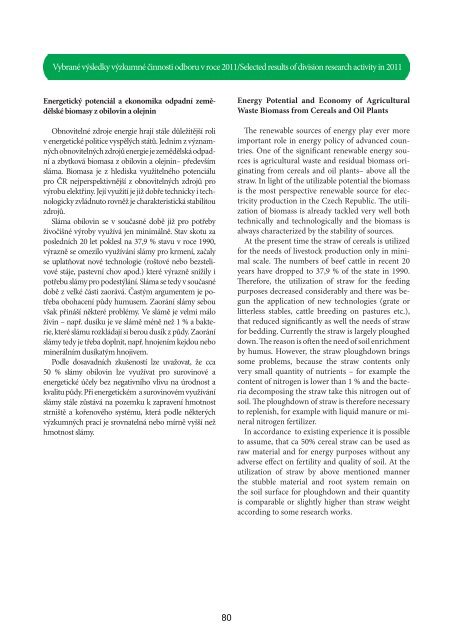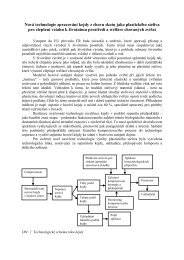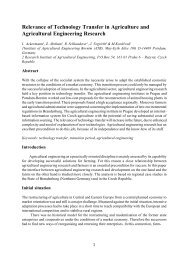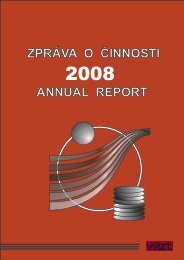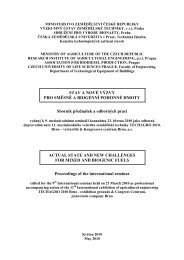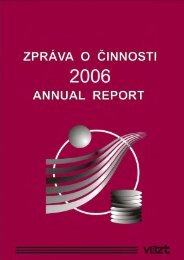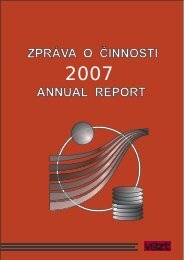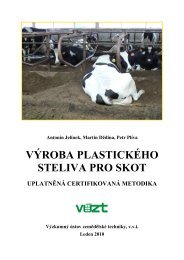Zpráva o ÄÂinnosti v roce 2011 (28MB) - SVT
Zpráva o ÄÂinnosti v roce 2011 (28MB) - SVT
Zpráva o ÄÂinnosti v roce 2011 (28MB) - SVT
Create successful ePaper yourself
Turn your PDF publications into a flip-book with our unique Google optimized e-Paper software.
Vybrané výsledky výzkumné činnosti odboru v <strong>roce</strong> <strong>2011</strong>/Selected results of division research activity in <strong>2011</strong>Energetický potenciál a ekonomika odpadní zemědělskébiomasy z obilovin a olejninObnovitelné zdroje energie hrají stále důležitější roliv energetické politice vyspělých států. Jedním z významnýchobnovitelných zdrojů energie je zemědělská odpadnía zbytková biomasa z obilovin a olejnin– předevšímsláma. Biomasa je z hlediska využitelného potenciálupro ČR nejperspektivnější z obnovitelných zdrojů provýrobu elektřiny. Její využití je již dobře technicky i technologickyzvládnuto rovněž je charakteristická stabilitouzdrojů.Sláma obilovin se v současné době již pro potřebyživočišné výroby využívá jen minimálně. Stav skotu zaposledních 20 let poklesl na 37,9 % stavu v <strong>roce</strong> 1990,výrazně se omezilo využívání slámy pro krmení, začalyse uplatňovat nové technologie (roštové nebo bezstelivovéstáje, pastevní chov apod.) které výrazně snížily ipotřebu slámy pro podestýlání. Sláma se tedy v současnédobě z velké části zaorává. Častým argumentem je potřebaobohacení půdy humusem. Zaorání slámy sebouvšak přináší některé problémy. Ve slámě je velmi máloživin – např. dusíku je ve slámě méně než 1 % a bakterie,které slámu rozkládají si berou dusík z půdy. Zaoráníslámy tedy je třeba doplnit, např. hnojením kejdou nebominerálním dusíkatým hnojivem.Podle dosavadních zkušeností lze uvažovat, že cca50 % slámy obilovin lze využívat pro surovinové aenergetické účely bez negativního vlivu na úrodnost akvalitu půdy. Při energetickém a surovinovém využíváníslámy stále zůstává na pozemku k zapravení hmotnoststrniště a kořenového systému, která podle některýchvýzkumných prací je srovnatelná nebo mírně vyšší nežhmotnost slámy.Energy Potential and Economy of AgriculturalWaste Biomass from Cereals and Oil PlantsThe renewable sources of energy play ever moreimportant role in energy policy of advanced countries.One of the significant renewable energy sourcesis agricultural waste and residual biomass originatingfrom cereals and oil plants– above all thestraw. In light of the utilizable potential the biomassis the most perspective renewable source for electricityproduction in the Czech Republic. The utilizationof biomass is already tackled very well bothtechnically and technologically and the biomass isalways characterized by the stability of sources.At the present time the straw of cereals is utilizedfor the needs of livestock production only in minimalscale. The numbers of beef cattle in recent 20years have dropped to 37,9 % of the state in 1990.Therefore, the utilization of straw for the feedingpurposes decreased considerably and there was begunthe application of new technologies (grate orlitterless stables, cattle breeding on pastures etc.),that reduced significantly as well the needs of strawfor bedding. Currently the straw is largely plougheddown. The reason is often the need of soil enrichmentby humus. However, the straw ploughdown bringssome problems, because the straw contents onlyvery small quantity of nutrients – for example thecontent of nitrogen is lower than 1 % and the bacteriadecomposing the straw take this nitrogen out ofsoil. The ploughdown of straw is therefore necessaryto replenish, for example with liquid manure or mineralnitrogen fertilizer.In accordance to existing experience it is possibleto assume, that ca 50% cereal straw can be used asraw material and for energy purposes without anyadverse effect on fertility and quality of soil. At theutilization of straw by above mentioned mannerthe stubble material and root system remain onthe soil surface for ploughdown and their quantityis comparable or slightly higher than straw weightaccording to some research works.80


